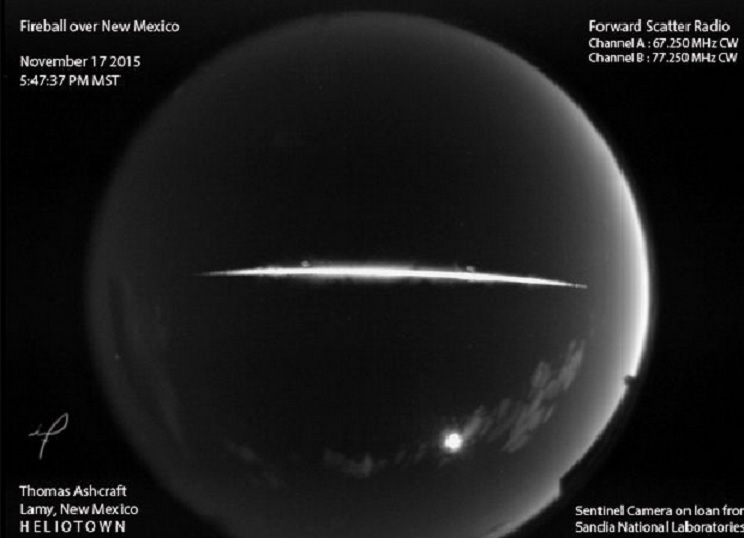
Lamy astronomer Thomas Ashcraft captured the event on his Sentinel camera on loan from Sandia National Laboratories.
Ashcraft said the Meteoroid Environment Office at NASA's Marshall Space Flight Center in Huntsville, Ala., confirmed that the 5:47 p.m. event was the result of a rare Taurid earth-grazer that was about as bright as the first-quarter moon.
"Earth-grazers enter earth's atmosphere at a very shallow angle and skim along the top of the atmosphere. Some actually skim and then re-enter space," Ashcraft wrote in an email. "This fireball was visible for eleven seconds and burned brightly its entire path of at least 180 miles. This means it had some mass to it to be able to burn that long."
Earth-grazers are not rare, but brighter ones, such as Tuesday's fireball, are special, Ashcraft said. "I'm not sure of the last time but I can tell you that a fireball of this size is not a common event over one location," he said. "That it was a long path earth-grazer makes it much more special."
Marshall Space Flight Center analyst Bill Cooke reported that the earth-grazer was seen from Colorado, New Mexico and as far away as Laramie, Wyo. "The meteor started at an altitude of 65 miles just east of the Kiowa National Grassland in New Mexico, and moved south of [due] west at 62,000 mph for over 180 miles," Cooke told Ashcraft after analyzing various reports. "It finally ablated 45 miles above the town of San Fidel, also in New Mexico. The brightness of this fragment of Comet Encke indicates that it was about 8 inches in diameter, with a weight around 20 pounds."
Comet Encke is a periodic comet that orbits the sun once every 3.3 years, Ashcraft said. "This comet spawns the Taurid meteor shower which was brighter and chunkier than usual this year and generated many fireballs around the planet," he said.
Eleven meteor observers reported what they saw Tuesday evening on an online reporting site called AMS Meteors. One meteor observer in La Salle, Colo., wrote that "the fireball was the biggest I've ever seen and the tail is the longest. It lasted a lot longer than I've ever seen one last too. When I first saw it I thought it was a jet liner on fire but it didn't take long to realize it was moving way too fast to be a plane. It was an incredible experience to see."
Another observer in Boulder, Colo., wrote, the "fireball seemed to grow with intensity ... WOW!"



Reader Comments
to our Newsletter